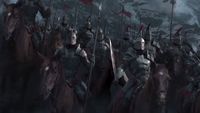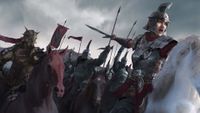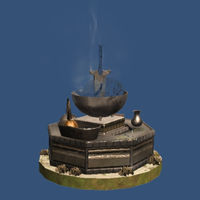Lore:Great War
This article is about the Fourth Era war. For the Second Era war, see Three Banners War.

The Great War, referred to as the First War Against the Empire by the Thalmor,[1] was a war fought from 4E 171 to 175 between the Third Empire and the Third Aldmeri Dominion. The war consisted primarily of a Dominion invasion of Imperial territory, culminating in the capture of the Imperial City before its recapture by the Empire, and the war eventually ended with the Empire signing a punishing peace deal.[2]
Background[edit]
After the Oblivion Crisis destabilized Summerset, the Sapiarchs of the Crystal Tower ceded power to the Thalmor and they subsequently seized total control in 4E 22, seceding from the Empire, and renaming the Summerset Isles to Alinor.[2] In 4E 29, the Thalmor took control of Valenwood in a coup, reforming the Aldmeri Dominion, while Elsweyr came under the influence of the Thalmor when they claimed credit for restoring the moons following the Void Nights crisis, resulting in the dissolution of the Elsweyr Confederacy and recreation of the kingdoms of Anequina and Pellitine as client states of the Aldmeri Dominion in 4E 115.[2]
The Empire of Cyrodiil, on the other hand, became progressively weaker; by the accession of Titus Mede II in 4E 168, the Empire had lost the provinces of Black Marsh, Elsweyr, Valenwood, and Morrowind[3][4]:109[5]:16, and found its province of Hammerfell severely weakened by renewed conflicts between the Crowns and Forebears.[2]
On the 30th of Frostfall, 4E 171, the Thalmor sent an ambassador to the Emperor to demand tributes, land, the disbandment of the Blades and the banning of Talos worship. The Emperor, despite being advised of the Empire's glaring military weakness, rejected the offer and was met with the heads of every Blades agent in Dominion territory. Thus began the Great War.[2]
The War[edit]
Within days of the declaration of war, two Thalmor armies assaulted simultaneously. One, led by Lady Arannelya, entered western Cyrodiil from Valenwood, bypassed its cities, and crossed to Hammerfell to join with Dominion attackers landing on its southern coast. The Dominion forces occupied the south, and the Empire retreated across the Alik'r Desert in the March of Thirst.[2] At least one battle took place in southern Hammerfell, as the soldier Angarion was named "Hero of the Battle of Roseguard".[6]
Concurrently, the Thalmor general and Daedra worshipper Lord Naarifin led a force into Cyrodiil from Elsweyr and seized Leyawiin. As they continued advancing in 4E 172, Naarifin seized Anvil and Bravil. By the end of the year, Naarifin had reached the Imperial City. As the Imperial Navy defended the Niben and Lake Rumare, legions from Skyrim joined the Imperial force in early 4E 173. The Dominion, however, crossed the Niben and surrounded the Imperial City on three sides, eventually seizing the city in 4E 174.[2] The Emperor broke out of the city,[2] retreating north to Skyrim and sacrificed one of his legions to hold Naarifin's forces.[7]
Ulfric Stormcloak, the son of the Jarl of Windhelm ended his tutelage under the Greybeard Monastic Order to fight in the war, but he was captured early on by the Thalmor. He was tortured and interrogated by Elenwen giving them information the Thalmor considered inconsequential, but they led him to believe that it had been crucial to the capture of the Imperial City. The Thalmor then decided to allow his escape, and deemed him an asset to their cause.
Naarifin's true endgame in the Imperial City was to bring about a prophecy entitled "The Culling" with the support of the Dremora blademaster Reive, a servant of Boethiah,[8] who led a cult in support of Naarifin's plan.[9] Naarifin also used the Orb of Vaermina to observe the Imperial army and predict its movements.[10]
In Hammerfell, Lady Arannelya's attempt to join Naarifin's forces had been foiled by General Decianus, who stopped her advance at Skaven. When he was ordered to reinforce the armies in Cyrodiil, he was torn between his obligations to Hammerfell and the Empire. As a compromise he discharged much of his army as "invalids"; these would become the core of the armies that would continue to defend Hammerfell, and thanks to them would lead Arannelya and the Dominion to believe that the Imperial Legions were still pinned down in Hammerfell.[2] Hammerfell's fortunes would continue to improve as the Forebear Armies of Sentinel came to reinforce and liberate the Crown city of Hegathe, leading to the reconciliation of the political conflict that had defined the Redguards of Hammerfell since its foundation.
In the winter of 4E 174 and 175, the Emperor regathered his forces with reinforcements from Hammerfell and Skyrim for an assault.[2] Having met a Forgotten Hero, and having been incapacitated by an assassin's attack, the Emperor appointed the Hero to lead the battle in his stead and guise.[11] Having breached the city, the Hero personally confronted Lord Naarifin and defeated him, closing the Oblivion gate he had opened to effect the Culling.[12] The Emperor took the credit,[13] and Lord Naarifin was reportedly kept alive for 33 days until either dying or being "carried off by a winged daedra", the former of which is the accepted story.[2]
During the war, other political factions in Tamriel did not cease activity. In Skyrim, the Reachmen took advantage of the Empire's absence to seize Markarth and the Reach from Nordic control, holding the city for two years.[14]
The White-Gold Concordat[edit]
After recapturing the Imperial City, with his Legions exhausted from the fighting and much of the Empire devastated, Titus Mede II signed the White-Gold Concordat in 4E 175. This peace treaty granted much the same concessions as were demanded by the Thalmor at the beginning of the war, but nonetheless the treaty was signed,[2] as a continuation of the war would have resulted in Imperial defeat.[15][16][17][18]
Local leaders, such as the kings (or "jarls") of Skyrim, were financially compensated after learning of its terms,[19] but many had oppositions to the treaty, eventually causing the Skyrim Civil War.[20] The White-Gold Concordat was especially hated for its banning of Talos worship,[2][21][22][23] especially by Nords who viewed this as a betrayal[24] despite propaganda produced to promote the Thalmor theology such as The Talos Mistake[25] and Imperial leniency in enforcement.[14] Following the Markarth Incident, the Emperor was forced to crack down on Talos worship and allow Thalmor Justiciars to enforce the ban on Talos worship.[26] Tensions led to Nordic disapproval of the Empire, which would also come to precipitate the Civil War.[27]
The Concordat also disbanded the Blades in retaliation for past offences.[28] Many, thus, were left to find new purposes; some, such as Delphine[28] and Azzin returned to the organization's Dragonguard roots and hunted Dragons,[29] while others such as the Warrior simply returned to their homes.[30]
Furthermore, the Concordat ceded much of Southern Hammerfell to the Aldmeri Dominion.[2] The Redguards, however, refused to accept this and fought the Dominion to a stalemate over the following five years and eventually signed the Second Treaty of Stros M'Kai.[2] Critics of Titus Mede point to Hammerfell's victory to show that the Empire could have denied the White-Gold Concordat and still achieved victory over the Dominion.
After the Great War many Legionnaires changed careers. The war hero Martius Silius became a gladiator in the Imperial Arena circuit, along with cohorts from his time in the War.[31] Some Nord veterans of the war such as Galmar Stone-Fist would go on to join Ulfric Stormcloak's rebellion,[32] while others such as Legate Rikke would remain with the Legion to extinguish the revolt,[33] while yet others simply retired, often proud of the service and keeping their armor as a token thereof.[34][35] King Durak gro-Batul of Bloodfall and many of his loyal soldiers fought on the side of the Empire during the Great War.[36]
Gallery[edit]
References[edit]
- ^ Thalmor Dossier: Ulfric Stormcloak
- ^ a b c d e f g h i j k l m n o The Great War — Legate Justianus Quintius
- ^ Adril Arano's dialogue in Skyrim: Dragonborn
- ^ The Infernal City — Greg Keyes
- ^ Lord of Souls — Greg Keyes
- ^ Angarion the Bold's dialogue in Blades
- ^ The Forgotten Hero questline in Legends
- ^ Reive's Wrath quest in Legends
- ^ Dark Omens quest in Legends
- ^ Interlude in Legends
- ^ A Knife in the Dark quest in Legends
- ^ The Showdown quest in Legends
- ^ Epilogue in Legends
- ^ a b The Bear of Markarth — Arrianus Arius, Imperial Scholar
- ^ Loading Screen in Skyrim
- ^ Hadvar's dialogue during Before the Storm in Skyrim
- ^ Ondolemar's dialogue during Diplomatic Immunity in Skyrim
- ^ Delphine's dialogue during A Blade in the Dark in Skyrim
- ^ Conversation between Balgruuf the Greater, Proventus Avenicci, and Irileth during Message to Whiterun in Skyrim
- ^ Ulfric Stormcloak's dialogue in Skyrim
- ^ Jora's dialogue in Skyrim
- ^ Heimskr's dialogue in Skyrim
- ^ Flight from the Thalmor — Hadrik Oaken-Heart
- ^ Nura Snow-Shod's dialogue in Skyrim
- ^ The Talos Mistake — Leonora Venatus
- ^ Alvor's dialogue in Skyrim
- ^ Skyrim's Rule — Abdul-Mujib Ababneh
- ^ a b Delphine's dialogue during Diplomatic Immunity in Skyrim
- ^ Azzin's dialogue during The Dragon Slayer in Blades
- ^ Blades
- ^ Metundus' dialogue in Blades
- ^ Galmar Stone-Fist's dialogue in Skyrim
- ^ Legate Rikke's dialogue in Skyrim
- ^ Brina Merilis' dialogue in Skyrim
- ^ Ambarys Rendar in Skyrim
- ^ Urzoga gra-Batul's dialogue in Blades
| |||||||||||||||||||||||||






